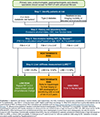Clinical Care Pathway for the Risk Stratification and Management of Patients With Nonalcoholic Fatty Liver Disease
- PMID: 34602251
- PMCID: PMC8819923
- DOI: 10.1053/j.gastro.2021.07.049
Clinical Care Pathway for the Risk Stratification and Management of Patients With Nonalcoholic Fatty Liver Disease
Abstract
Find AGA's NASH Clinical Care Pathway App for iOS and Android mobile devices at nash.gastro.org. Scan this QR code to be taken directly to the website.Nonalcoholic fatty liver disease (NAFLD) is becoming increasingly common, currently affecting approximately 37% of US adults. NAFLD is most often managed in primary care or endocrine clinics, where clinicians must determine which patients might benefit from secondary care to address hepatic manifestations, comorbid metabolic traits, and cardiovascular risks of the disease. Because NAFLD is largely asymptomatic, and because optimal timing of treatment depends on accurate staging of fibrosis risk, screening at the primary care level is critical, together with consistent, timely, evidence-based, widely accessible, and testable management processes. To achieve these goals, the American Gastroenterological Association assembled a multidisciplinary panel of experts to develop a Clinical Care Pathway providing explicit guidance on the screening, diagnosis, and treatment of NAFLD. This article describes the NAFLD Clinical Care Pathway they developed and provides a rationale supporting proposed steps to assist clinicians in diagnosing and managing NAFLD with clinically significant fibrosis (stage F2-F4) based on the best available evidence. This Pathway is intended to be applicable in any setting where care for patients with NAFLD is provided, including primary care, endocrine, obesity medicine, and gastroenterology practices.
Keywords: Clinical Care Pathway; Liver Disease; NAFLD; NASH; Nonalcoholic Fatty Liver Disease; Nonalcoholic Steatohepatitis.
Copyright © 2021. Published by Elsevier Inc.
Figures
Comment in
-
Clinical Care Pathway for the Risk Stratification and Management of Patients With Non-alcoholic Fatty Liver Disease.Gastroenterology. 2022 Jun;162(7):2131-2132. doi: 10.1053/j.gastro.2022.01.013. Epub 2022 Jan 13. Gastroenterology. 2022. PMID: 35032500 No abstract available.
Similar articles
-
AGA Clinical Practice Update on the Role of Noninvasive Biomarkers in the Evaluation and Management of Nonalcoholic Fatty Liver Disease: Expert Review.Gastroenterology. 2023 Oct;165(4):1080-1088. doi: 10.1053/j.gastro.2023.06.013. Epub 2023 Aug 4. Gastroenterology. 2023. PMID: 37542503 Review.
-
AGA Clinical Practice Update: Diagnosis and Management of Nonalcoholic Fatty Liver Disease in Lean Individuals: Expert Review.Gastroenterology. 2022 Sep;163(3):764-774.e1. doi: 10.1053/j.gastro.2022.06.023. Epub 2022 Jul 14. Gastroenterology. 2022. PMID: 35842345 Free PMC article.
-
Preparing for the NASH Epidemic: A Call to Action.Gastroenterology. 2021 Sep;161(3):1030-1042.e8. doi: 10.1053/j.gastro.2021.04.074. Epub 2021 Jul 26. Gastroenterology. 2021. PMID: 34416976
-
Management of nonalcoholic fatty liver disease: an evidence-based clinical practice review.World J Gastroenterol. 2014 Sep 14;20(34):12182-201. doi: 10.3748/wjg.v20.i34.12182. World J Gastroenterol. 2014. PMID: 25232252 Free PMC article. Review.
-
Risk stratification of patients with nonalcoholic fatty liver disease using a case identification pathway in primary care: a cross-sectional study.CMAJ Open. 2020 May 15;8(2):E370-E376. doi: 10.9778/cmajo.20200009. Print 2020 Apr-Jun. CMAJ Open. 2020. PMID: 32414883 Free PMC article.
Cited by
-
Making Sense of the Nonalcoholic Fatty Liver Disease Clinical Practice Guidelines: What Clinicians Need to Know.Diabetes Spectr. 2024 Winter;37(1):29-38. doi: 10.2337/dsi23-0014. Epub 2024 Feb 15. Diabetes Spectr. 2024. PMID: 38385100 Free PMC article.
-
Objective Measures of Cardiometabolic Risk and Advanced Fibrosis Risk Progression in Primary Care Patients With Metabolic Dysfunction-Associated Steatotic Liver Disease.Endocr Pract. 2024 Nov;30(11):1015-1022. doi: 10.1016/j.eprac.2024.08.002. Epub 2024 Aug 8. Endocr Pract. 2024. PMID: 39127111
-
Nonalcoholic steatohepatitis/metabolic dysfunction-associated steatohepatitis emerging market: Preparing managed care for early intervention, equitable access, and integrating the patient perspective.J Manag Care Spec Pharm. 2024 Sep;30(9-a Suppl):S1-S13. doi: 10.18553/jmcp.2024.30.9-a.s1. J Manag Care Spec Pharm. 2024. PMID: 39213163 Free PMC article. Review.
-
Comparison of Guidelines for the Screening, Diagnosis, and Noninvasive Assessment of Nonalcoholic Fatty Liver Disease.J Clin Exp Hepatol. 2023 Sep-Oct;13(5):783-793. doi: 10.1016/j.jceh.2023.01.016. Epub 2023 Feb 5. J Clin Exp Hepatol. 2023. PMID: 37693272 Free PMC article. Review.
-
Taiwan Association for the Study of the Liver-Taiwan Society of Cardiology Taiwan position statement for the management of metabolic dysfunction- associated fatty liver disease and cardiovascular diseases.Clin Mol Hepatol. 2024 Jan;30(1):16-36. doi: 10.3350/cmh.2023.0315. Epub 2023 Oct 4. Clin Mol Hepatol. 2024. PMID: 37793641 Free PMC article. Review.
References
-
- Ciardullo S, Monti T, Perseghin G. High prevalence of advanced liver fibrosis assessed by transient elastography among U.S. adults with type 2 diabetes. Diabetes Care 2021;44:519–525. - PubMed
-
- Harrison SA, Gawrieh S, Roberts K, et al. Prospective evaluation of the prevalence of non-alcoholic fatty liver disease and steatohepatitis in a large middle-aged US cohort. J Hepatol 2021;75:284–291. - PubMed
Publication types
MeSH terms
Grants and funding
- U01 DK130190/DK/NIDDK NIH HHS/United States
- UL1 TR001442/TR/NCATS NIH HHS/United States
- P42 ES010337/ES/NIEHS NIH HHS/United States
- P30 DK120515/DK/NIDDK NIH HHS/United States
- U01 AA029019/AA/NIAAA NIH HHS/United States
- U01 DK061734/DK/NIDDK NIH HHS/United States
- P01 HL147835/HL/NHLBI NIH HHS/United States
- R01 DK121378/DK/NIDDK NIH HHS/United States
- R01 DK101737/DK/NIDDK NIH HHS/United States
- R56 DK088837/DK/NIDDK NIH HHS/United States
- R01 DK106419/DK/NIDDK NIH HHS/United States
- U01 DK061713/DK/NIDDK NIH HHS/United States
- U01 CA230997/CA/NCI NIH HHS/United States
- R01 DK111866/DK/NIDDK NIH HHS/United States
- R01 DK099205/DK/NIDDK NIH HHS/United States
- R01 AA028550/AA/NIAAA NIH HHS/United States
- P30 DK056338/DK/NIDDK NIH HHS/United States
- R01 DK124318/DK/NIDDK NIH HHS/United States
LinkOut - more resources
Full Text Sources
Medical
Miscellaneous




